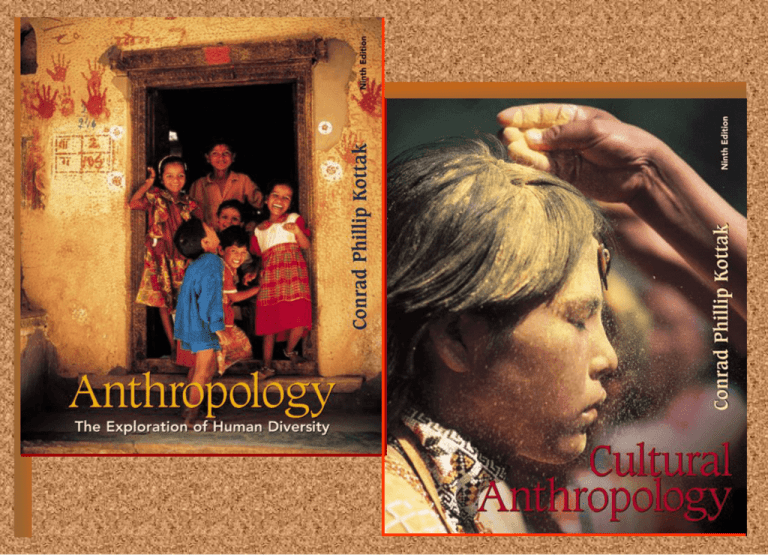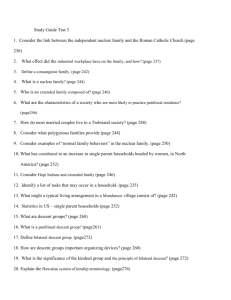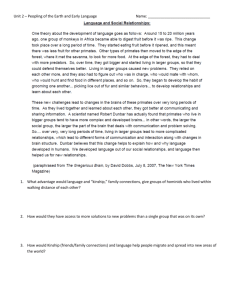
McGraw-Hill
© 2002 by The McGraw-Hill Companies, Inc. All rights reserved.
Using These Slides
These PowerPoint slides have been designed for use by students and instructors using the
Anthropology: The Exploration of Human Diversity textbook by Conrad Kottak. These files
contain short outlines of the content of the chapters, as well as selected photographs, maps,
and tables. Students may find these outlines useful as a study guide or a tool for review.
Instructors may find these files useful as a basis for building their own lecture slides or as
handouts. Both audiences will notice that many of the slides contain more text than one would
use in a typical oral presentation, but it was felt that it would be better to err on the side of a
more complete outline in order to accomplish the goals above. Both audiences should feel
free to edit, delete, rearrange, and rework these files to build the best personalized outline,
review, lecture, or handout for their needs.
McGraw-Hill
© 2002 by The McGraw-Hill Companies, Inc. All rights reserved.
Contents of Student CD-ROM
Student CD-ROM—this fully interactive
student CD-ROM is packaged free of charge
with every new textbook and features the
following unique
tools:
How To Ace This Course:
•Animated book walk-through
•Expert advice on how to succeed in the
course (provided on video by the University
of Michigan)
•Learning styles assessment program
•Study skills primer
•Internet primer
•Guide to electronic research
Chapter-by-Chapter Electronic Study Guide:
•Video clip from a University of Michigan
lecture on the text chapter
•Interactive map exercise
•Chapter objectives and outline
•Key terms with an audio pronunciation guide
•Self-quizzes (multiple choice, true/false, and
short-answer questions with feedback
indicating why your answer is correct or
incorrect)
•Critical thinking essay questions
•Internet exercises
•Vocabulary flashcards
•Chapter-related web links
Cool Stuff:
•Interactive globe
•Study break links
McGraw-Hill
© 2002 by The McGraw-Hill Companies, Inc. All rights reserved.
Contents of
Online Learning Center
Student’s Online Learning Center—this free web-based student supplement features many of
the same tools as the Student CD-ROM (so students can access these materials either online or
on CD, whichever is convenient), but also includes:
•An entirely new self-quiz for each chapter (with feedback, so students can take two pre-tests
prior to exams)
•Career opportunities
•Additional chapter-related readings
•Anthropology FAQs
•PowerPoint lecture notes
•Monthly updates
McGraw-Hill
© 2002 by The McGraw-Hill Companies, Inc. All rights reserved.
C Families, Kinship, and Descent
h
This chapter introduces students to the
a anthropological study of kinship. It
discusses the different classifications that
p anthropologists use for kin groups, descent
and residence, and kinship terminology
t systems.
e
r
15
McGraw-Hill
© 2002 by The McGraw-Hill Companies, Inc. All rights reserved.
Nuclear and Extended Families
The nuclear family consists of a married couple and their
children.
The nuclear family is ego-centered, and impermanent, while
descent groups are permanent (lasting beyond the lifespans
of individual constituents) and reckoned according to a
single ancestor.
One’s family of orientation is the family in which one is
born and grows up, while one’s family of procreation is
formed when one marries and has children.
Claims made for the universality of the nuclear family,
based upon the universality of marriage, do not hold up—
the nuclear family is widespread, but not universal.
McGraw-Hill
© 2002 by The McGraw-Hill Companies, Inc. All rights reserved.
Nuclear and Extended Families
In societies where the nuclear family is important, this
structure acts as a primary arena for sexual, reproductive,
economic, and enculturative functions, but it is not the only
structure used by societies for these (e.g., the Etoro, Nayar,
Betsileo, etc.).
In many societies, the extended families are the primary unit
of social organization.
Among the Muslims of western Bosnia, nuclear families are
embedded within large extended families called zadrugas
headed by a male household head and his wife.
The Nayars are a matrilineal society in which extended
families live in compounds called tarawads headed by a senior
woman.
McGraw-Hill
© 2002 by The McGraw-Hill Companies, Inc. All rights reserved.
Nuclear and Extended Families
Map showing the Kerala state in India,
where the Nayars live.
McGraw-Hill
© 2002 by The McGraw-Hill Companies, Inc. All rights reserved.
Industrialism & Family Organization
The most prevalent residence pattern in the United States is
families of procreation living neolocally.
In the US, as in other large, industrialized societies, patterns
of residence and family types may change from class to
class, in response to the conditions of these different
contexts (e.g., extended families as a response to poverty).
McGraw-Hill
© 2002 by The McGraw-Hill Companies, Inc. All rights reserved.
Changes in North American Kinship
In 1995, 25 percent of American households were inhabited
by nuclear families.
Increasing representation of women in the work force is
associated with a rise in marriage age.
The divorce rate rose steeply between 1970 and 1994.
The media is reflecting and intensifying these changes.
Comparatively, Americans (especially middle class) identify
a smaller range of kindred than members of nonindustrial
societies.
A comparison between American and Brazilian kinship is
made.
McGraw-Hill
© 2002 by The McGraw-Hill Companies, Inc. All rights reserved.
The Family Among Foragers
The two basic units of social organization among foragers
are the nuclear family and the band.
Typically, the band exists only seasonally, breaking up into
nuclear families when subsistence means require it.
McGraw-Hill
© 2002 by The McGraw-Hill Companies, Inc. All rights reserved.
Descent Groups
A descent group is a permanent social unit whose members
claim common ancestry.
With matrilineal descent individuals automatically join the
mother’s descent group when they are born.
With patrilineal descent individuals automatically join the
father’s descent group when they are born.
Matrilineal and patrilineal descent are types of unilineal
descent in which individuals only recognize one line of
descent.
McGraw-Hill
© 2002 by The McGraw-Hill Companies, Inc. All rights reserved.
Descent Groups
A lineage is a descent group who can demonstrate their
common descent from an apical ancestor.
A clan is a descent group who claims common descent from
an apical ancestor but cannot demonstrate it (stipulated
descent).
When a clan’s apical ancestor is nonhuman, it is called a
totem.
McGraw-Hill
© 2002 by The McGraw-Hill Companies, Inc. All rights reserved.
Descent Groups
A matrilineage five
generations deep.
McGraw-Hill
© 2002 by The McGraw-Hill Companies, Inc. All rights reserved.
Descent Groups
A
patrilineage
five
generations
deep.
McGraw-Hill
© 2002 by The McGraw-Hill Companies, Inc. All rights reserved.
Lineages, Clans, and Residence Rules
In tribal societies, the descent group, not the nuclear family,
is the fundamental unit.
In many societies, descent groups are corporate, sharing
resources and property.
Unilocal Residence
Patrilocality—married couple lives with husband's family;
associated with patrilineal descent and is more common than
matrilocality.
Matrilocality—married couple lives with wife's family;
associated with matrilineal descent and is less than
patrilocaility.
McGraw-Hill
© 2002 by The McGraw-Hill Companies, Inc. All rights reserved.
Ambilineal Descent
People can choose the descent group that they want to
belong to.
Membership is fluid as people can change their descent
group membership.
With unilineal descent, membership is ascribed, but for
ambilineal descent, membership is achieved.
McGraw-Hill
© 2002 by The McGraw-Hill Companies, Inc. All rights reserved.
Kinship Calculation
Kinship calculation is any systemic method for reckoning
kin relations.
Genealogical Kin Types and Kin Terms.
Kin terms are the labels given in a particular culture to
different kinds of relatives.
Biological kin type refers to the degree of actual
genealogical relatedness.
McGraw-Hill
© 2002 by The McGraw-Hill Companies, Inc. All rights reserved.
Kinship Calculation
Kinship symbols and genealogical kin
type notation.
McGraw-Hill
© 2002 by The McGraw-Hill Companies, Inc. All rights reserved.
Bilateral Kinship
Bilateral kinship is used by most Americans and Canadians.
Kinship is traced through both male and female lines.
Kin links through males and females are perceived as being
similar or equivalent.
In North American bilateral kinship there is often matrilineal
skewing, a preference for relatives on the mother's side.
McGraw-Hill
© 2002 by The McGraw-Hill Companies, Inc. All rights reserved.
Kinship Terminology
Kinship terminologies are native taxonomies (emic), not
developed by anthropologists.
Lineal terminology: most Americans and Canadians use
lineal terminology, which distinguishes lineal, collateral, and
affinal relatives.
Bifurcate merging terminology: this is the most common,
associated with unilineal descent and unilocal residence.
Generational terminology: typical of ambilineal societies,
this calls ascending, same sex relatives by the same names.
Bifurcate collateral terminology: common to North Africa
and the Middle East, this is the most particular system.
McGraw-Hill
© 2002 by The McGraw-Hill Companies, Inc. All rights reserved.
Kinship Terminology
Four systems of kinship terminology.
Kinship
Terminology
Kin Group
Residence Rule
Lineal
Nuclear family
Neolocal
Bifurcate merging
Unilineal descent
group – patrilineal
or matrilineal
Patrilocal or
matrilocal
Generational
Ambilineal
descent group,
band
Varies
Ambilocal
Bifurcate
collateral
McGraw-Hill
Varies
Economy
Industrialism,
foraging
Horticulture,
pastoralism,
agriculture
Agriculture,
horticulture,
foraging
Varies
© 2002 by The McGraw-Hill Companies, Inc. All rights reserved.
Kinship Terminology
The distinctions
among Lineals,
Collaterals, and
Affinals as
perceived by
Ego.
McGraw-Hill
© 2002 by The McGraw-Hill Companies, Inc. All rights reserved.
Lineal Kinship Terminology
A lineal kinship terminology system.
McGraw-Hill
© 2002 by The McGraw-Hill Companies, Inc. All rights reserved.
Bifurcate Merging Kinship
Bifurcate Merging kinship terminology.
McGraw-Hill
© 2002 by The McGraw-Hill Companies, Inc. All rights reserved.
Generational Kinship Terminology
Generational kinship terminology system.
McGraw-Hill
© 2002 by The McGraw-Hill Companies, Inc. All rights reserved.
Bifurcate Collateral Kinship
Bifurcate Collateral kinship terminology system.
McGraw-Hill
© 2002 by The McGraw-Hill Companies, Inc. All rights reserved.








